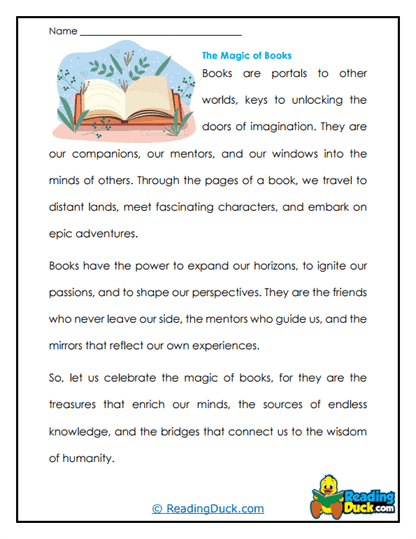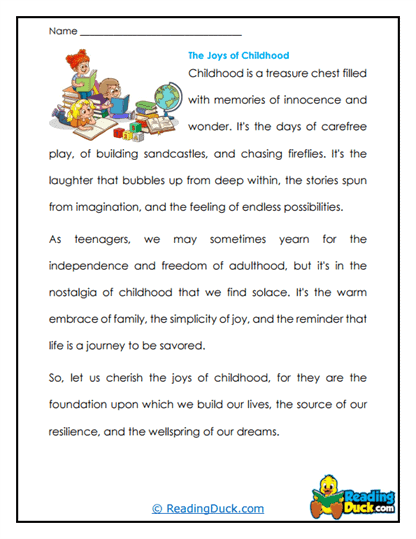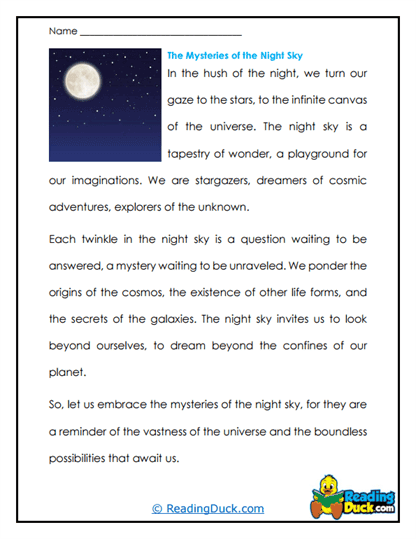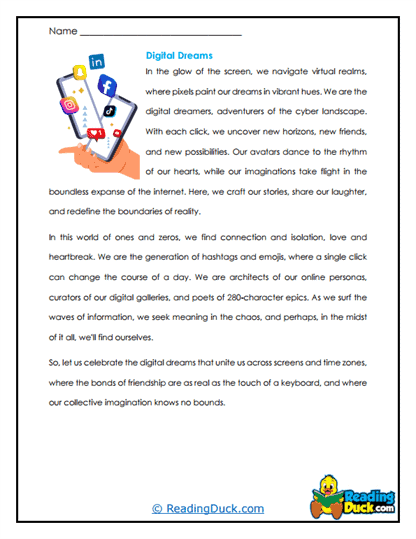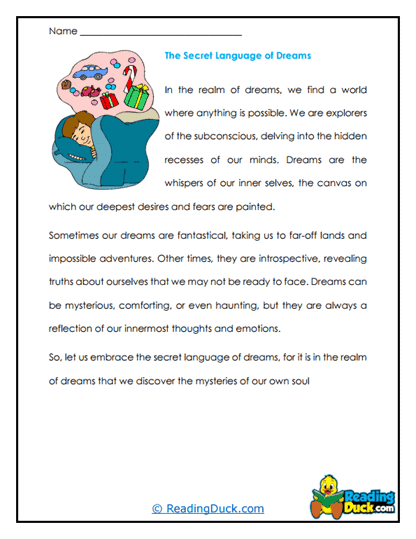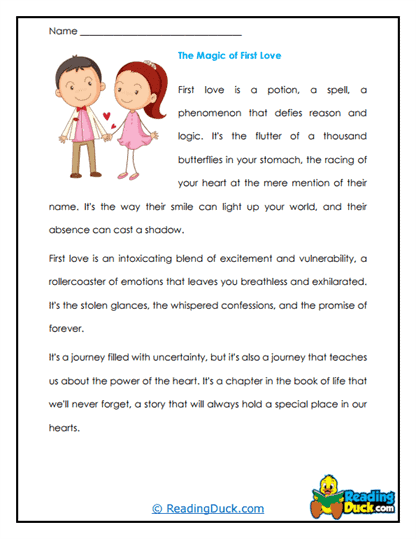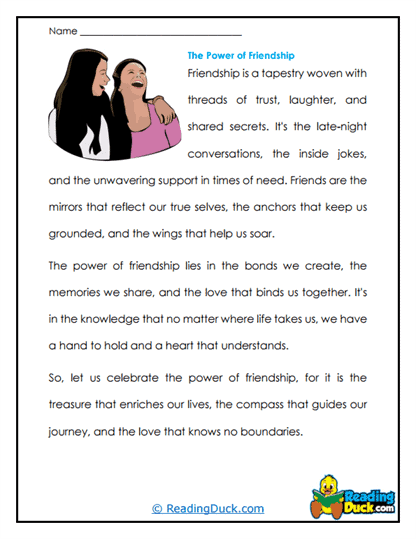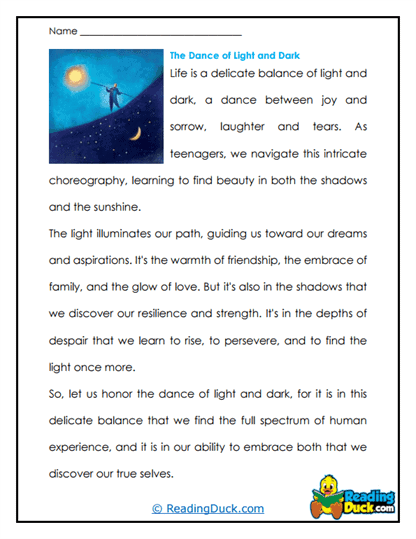Prose Poetry Worksheets
About Our Prose Poetry Worksheets
Our Prose Poetry Worksheets offer an immersive and intellectually stimulating way for students to explore a unique and hybrid form of literature that blends the boundaries between prose and poetry. As part of the Reading Poetry category within the Genres section, these worksheets focus on prose poetry, which retains the richness of poetic language and imagery without adhering to traditional line breaks or verse structure. Each worksheet set includes a reading passage representative of the prose poetry genre and is accompanied by multiple-choice, short answer, and open-ended response questions that encourage students to engage with the text on multiple levels.
These worksheets are available in a convenient PDF format for easy downloading, printing, and use in various educational settings. They also include a downloadable answer key to streamline grading and assessment, ensuring that teachers and homeschool educators can quickly provide feedback. With these worksheets, students gain valuable skills in reading comprehension, critical analysis, and creative expression while enjoying the challenge of interpreting prose poetry.
Understanding Prose Poetry: Themes, Characteristics, and Its Importance in Poetry
Prose poetry is a genre that defies the traditional boundaries of verse. It uses the heightened language, imagery, and rhythm typically associated with poetry, but it is presented in the format of prose—without line breaks, stanzas, or strict meter. Prose poetry creates a rich blend of lyrical expression and narrative style, allowing poets to explore emotions, scenes, or concepts in a more fluid and expansive way than traditional poetry might permit.
Key themes in prose poetry can range from the personal and introspective to the philosophical and observational. Because the form allows for a seamless combination of poetic devices and narrative elements, prose poetry often explores complex human emotions, abstract ideas, or vivid descriptions of the everyday. The genre is marked by its ability to capture moments of beauty or insight while maintaining the flow and structure of prose.
Prose poetry is essential to the study of poetry because it challenges conventional notions of what poetry can be. It demonstrates that the poetic quality of language can transcend formal constraints, showing students how metaphor, symbolism, rhythm, and other literary devices can operate within the boundaries of prose. By studying prose poetry, students learn to think more flexibly about the use of language and are encouraged to experiment with form and structure in their own writing.
- Key Themes: Human emotion, introspection, philosophical exploration, everyday observations.
- Characteristics: No line breaks or stanzas, use of poetic devices such as metaphor and symbolism, rhythmic and lyrical language.
- Significance: Prose poetry expands the boundaries of traditional poetry, helping students appreciate how poetic language can flourish within the structure of prose.
These worksheets allow students to explore the complexities and possibilities of prose poetry while offering educators an accessible, user-friendly resource in PDF format with easy-to-use answer keys.
Enhancing Literary Skills Through Prose Poetry
Our Prose Poetry Worksheets are designed to help students develop essential literary skills such as reading comprehension, critical thinking, and creative expression. By studying prose poetry, students are exposed to a unique form of writing that challenges them to look beyond traditional poetic structures while still engaging with the rich language and imagery of poetry.
Multiple-choice questions in each worksheet focus on helping students identify key elements of the prose poem, such as the theme, tone, and literary devices used. These questions serve as a foundation for understanding the basic structure and meaning of the poem, ensuring that students grasp the essential components before moving on to more in-depth analysis.
Short answer questions prompt students to engage with specific aspects of the text, such as analyzing the impact of a particular metaphor, examining the use of imagery, or explaining how the rhythm contributes to the overall effect of the piece. Open-ended response questions encourage students to reflect on the broader themes of the prose poem and consider how the combination of prose and poetry enhances the expression of ideas or emotions.
Through working on these exercises, students will strengthen key skills:
- Reading Comprehension: Students learn to identify and interpret the key elements of prose poetry, such as tone, theme, and imagery.
- Critical Thinking: Analyzing how poetic devices function within the prose format encourages students to think deeply about the use of language.
- Creative Expression: Open-ended responses allow students to explore their interpretations of the prose poem and its emotional or philosophical dimensions.
These worksheets offer students the tools they need to engage thoughtfully with prose poetry and deepen their understanding of how language can function across different genres.
Versatility for a Variety of Learning Environments
The adaptability of our Prose Poetry Worksheets makes them a valuable resource for use in classrooms, homeschooling, and independent study. Prose poetry’s flexibility as a genre lends itself well to a variety of teaching methods, making these worksheets suitable for both group activities and individual assignments.
In a classroom setting, these worksheets can serve as the foundation for group discussions, where students compare their interpretations of a prose poem or explore how the genre differs from traditional verse poetry. Teachers can also use the worksheets to facilitate group projects, where students work together to analyze the use of metaphor, symbolism, or rhythm in different prose poems. The worksheets provide an excellent resource for individual assignments, where students work independently to deepen their understanding of prose poetry through close reading and analysis.
For homeschooling, the Prose Poetry Worksheets offer a structured yet flexible approach to teaching poetry. Homeschool educators can use these worksheets to guide students through a step-by-step analysis of prose poetry, with opportunities for more in-depth exploration and creative writing. The format is easily adaptable to different skill levels, making it suitable for students with varying degrees of familiarity with poetry.
Independent learners will also find these worksheets accessible and engaging. The self-paced nature of the worksheets allows students to explore prose poetry on their own terms, while the downloadable answer key provides immediate feedback for self-assessment. This makes the worksheets an ideal resource for independent study or enrichment activities outside of traditional classroom settings.
- Classroom Use: Ideal for group discussions, collaborative projects, or individual analysis.
- Homeschooling: Structured yet flexible resources that can be tailored to different learning styles and levels.
- Independent Study: Self-paced learning with immediate feedback through downloadable answer keys.
The versatility of these worksheets ensures that they can be adapted to a wide range of learning environments, providing both structure and flexibility for students and educators alike.
Developing Analytical Skills and Understanding Literary Devices
Prose poetry provides an excellent opportunity for students to develop their analytical skills and deepen their understanding of literary devices such as metaphor, symbolism, imagery, and rhythm. Our Prose Poetry Worksheets are designed to guide students through the process of close reading and analysis, helping them understand how the elements of prose and poetry combine to create meaning.
Through genre-specific questions, students are encouraged to examine how the lack of line breaks and stanzas in prose poetry affects the reading experience, while still allowing for the use of rich poetic language. For example, a worksheet might ask students to analyze how the rhythm of a prose poem mirrors the natural cadence of speech, or how the use of metaphor transforms a mundane scene into a moment of introspection or beauty. By focusing on specific literary devices, students gain a deeper appreciation for how prose poetry can convey emotion and meaning in subtle, yet powerful ways.
The close reading exercises encourage students to pay attention to the nuances of the text, teaching them to think critically about how the choice of words, sentence structure, and imagery contribute to the overall effect of the poem. These analytical skills are not only essential for understanding prose poetry but also for interpreting more traditional forms of poetry and other literary works.
- Close Reading: Encourages students to examine the nuances of language and structure in prose poetry.
- Literary Devices: Focus on metaphor, symbolism, imagery, and rhythm, and how they contribute to the poem’s meaning.
- Critical Analysis: Helps students develop confidence in analyzing and interpreting complex literary texts.
By working through these exercises, students will build the skills needed to engage deeply with prose poetry and other forms of literature.
Encouraging Creative Expression Through Prose Poetry Writing
One of the most rewarding aspects of studying prose poetry is the opportunity for students to engage in creative writing. Our Prose Poetry Worksheets include guided writing prompts that encourage students to experiment with prose poetry, blending poetic language with the structure of prose to express their own thoughts, emotions, and observations.
Each worksheet set includes creative exercises where students are asked to compose their own prose poems based on themes or topics they have explored in their readings. For example, students might be prompted to write a prose poem that describes a personal memory, a scene from nature, or a philosophical reflection, using rich imagery and metaphor to convey emotion. These prompts encourage students to apply the techniques they’ve studied, such as the use of rhythm and poetic devices, in their own writing.
Writing prose poetry helps students develop their voice as writers while also deepening their understanding of how form and content work together in poetry. The flexibility of prose poetry allows students to experiment with language and structure, giving them the freedom to express their ideas in a creative, yet disciplined way.
- Writing Prompts: Guided exercises encourage students to create their own prose poems based on specific themes or experiences.
- Creative Expression: Allows students to explore their emotions, ideas, and observations through poetic language.
- Form and Technique: Helps students apply literary devices and techniques they have learned in a structured yet flexible format.
These creative writing exercises provide students with an engaging way to explore prose poetry, helping them develop both their writing skills and their appreciation for the genre.
Conclusion: A Comprehensive Tool for Studying Prose Poetry
Our Prose Poetry Worksheets provide a comprehensive and engaging resource for students and educators, offering a thoughtful approach to studying one of the most versatile and imaginative forms of poetry. By combining reading comprehension, critical analysis, and creative writing, these worksheets encourage students to appreciate the unique qualities of prose poetry while building essential literary skills.
Whether used in classrooms, homeschooling environments, or independent study, these worksheets offer a flexible and accessible way to explore the genre. Through guided reading exercises, analytical questions, and creative writing prompts, students gain a deeper understanding of how prose poetry blends the best elements of prose and poetry to create something powerful and thought-provoking. With our Prose Poetry Worksheets, students not only learn to interpret and analyze this hybrid genre but also have the opportunity to craft their own prose poems, discovering the beauty and complexity of this dynamic form.
